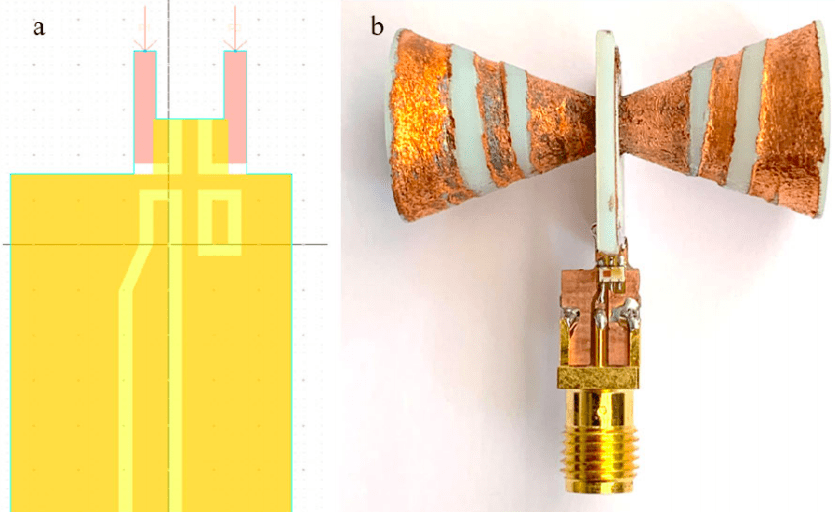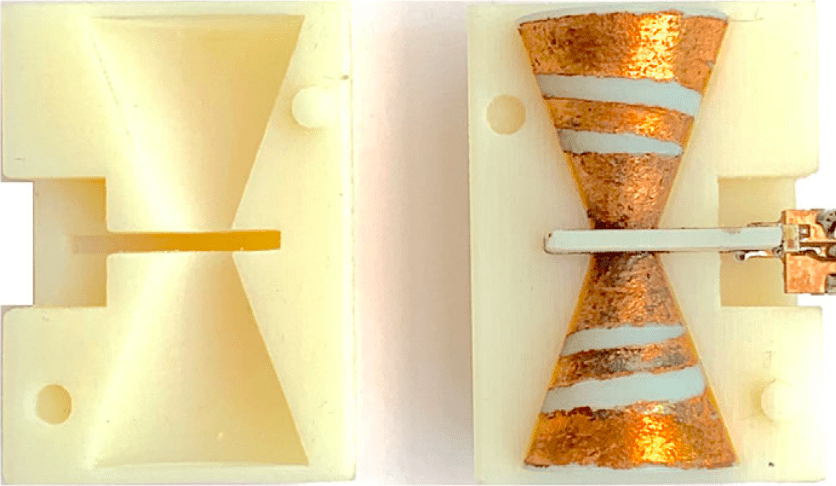Scientists from the University of Barcelona and Universitat Politècnica de Catalunya, have designed and 3D printed an enhanced, more reliable UHF-RFID (Radio Frequency Identification) tag.
The team’s inventory tracking device features a biconical antenna design with embedded wire strips to improve its overall bandwidth, and a dielectric coating to prevent its signal from being interfered with. Summary testing showed that the tag could be integrated seamlessly into existing networks, potentially enabling its use as a stock management tool within new areas such as the medical, construction, or automotive sectors.

Advanced additive antenna applications
The potential of additive manufacturing in the development of more compact antenna systems has already been realized within a broad range of end-use applications. For instance, scientists are currently attempting to 3D print low-cost antennas for the UK’s 5G network, while aerospace firm SENER Aeroespacial is printing a metal sensor for the PROBA-3 space mission.
Similarly, researchers from the University of Delaware (UDEL) are using an XJet Carmel 1400 3D printer to develop their own 5G antennas, amongst other microwave-related devices. Now the Barcelona-based team have identified RFID technology as another possible beneficiary of the cost savings and complex geometries enabled by 3D printing manufacturing techniques.
RFID chips are widely used within industrial areas as a means of tracking inventory, controlling staff access and various logistical applications, but they still have limitations. Sometimes, when the devices are operated in places with changeable electromagnetic (EM) conditions, the activation range of the chip can be limited.
Hospitals in particular, often cause RFID tags to malfunction, as EM devices are prevalent in medical care, and the radiative efficiency of the tracking chips can be affected as a result. Elsewhere, in the automotive and construction sectors, the inability of RFID devices to work while fully-immersed, has prevented their use within certain areas of the manufacturing workflow too.

The Barcelona team’s upgraded RFID device
In order to overcome the limitations of existing RFID tags, the researchers designed a novel antenna layout which prevents signal reactance when the device is submerged in another medium. The team’s chip design comprises two main symmetrical radiators, a matching network and a dielectric coating, which is optimized to work at certain frequencies.
The antenna’s body features a biconical structure with a metal plate down the middle, that has been pre-programmed with a dielectric constant of 2.8 and loss tangent of 0.02. Two square metal strips are also wound around both sides of the plate and connected via a hole, which ultimately allows the broadband of the antenna to be matched to that of an RFID chip.
Leveraging advanced EM simulation software in the design of their device, allowed the researchers to optimize it for use with common RFID frequencies. Once the team’s final product was ready, they manufactured its dielectric coating by 3D printing its cylindrical polymer body in two halves, before connecting them to encapsulate the antenna inside.
The antenna was also coated in conductive silver ink, which was used as a seed for a copper electroplating process. Once complete, the device’s conical structures were covered in a thin layer of the alloy, which allowed it to successfully receive and transmit signals.

Subsequent testing revealed some mismatches between the scientists’ simulations and the performance of their prototype, especially with regards to bandwidth. Given the complexity of the device’s geometry, the accuracy of its final design varied in precision in certain areas, which had a knock-on effect on the chip’s EM behavior.
Despite this, when the final prototype of the team’s RFID chip was evaluated using a commercial ‘‘Alien ALR-9900+’’ reader, it performed considerably better. Once lofted in the air, the device could be read from 4.5 meters away, and when the chip was fully immersed, it maintained a detection range of 40 percent, which was consistent with simulations.
Consequently, the research team considered their design to be a success, and the finished device to be unique in that it is optimized for embedded applications. Testing showed that the RFID tag was able to effectively minimize the impact of external conditions, which could enable its use within new industries that feature particularly erratic EM conditions.
The researchers’ findings are detailed in their paper titled “3D-Printed UHF-RFID Tag for Embedded Applications.” The paper was co-authored by Neus Vidal, Josep Maria Lopez-Villegas, Jordi Romeu, Arnau Salas Barenys, Aleix Garcia-Miquel, Giselle Gonzalez-Lopez and Luis Jofre.


